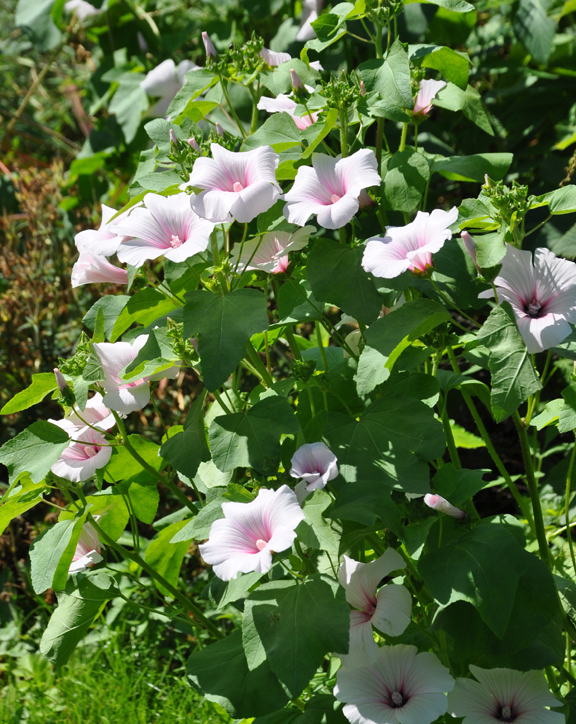If the vibrant blue color of the house on corner of Victoria Street doesn't grab your attention, the charming cottage garden certainly does. Bright annuals overflow the window boxes and flowers spill onto the sidewalk in front of the white picket fence. As a whole the exterior is so distinctive, you don't have to pass through the front arbor, smothered in Clematis vines, to know that someone creative lives there.
"Blue is my favourite, but the idea to paint the house a bright blue comes from trips to the East coast and Sweden, where they prefer vibrant colors over the boring, bland colors that we tend to use here in Ontario," homeowner Candace Carter says, "In the beginning there were reservations expressed by the neighbours on the blue, but now they seem to like it. I have had many compliments on the choice, especially from photographers, who like the vibrant color as a backdrop to the flowers."
The simple structure dates back to the 1860's and is one of the first homes built in Claremont, Ontario. Candace and her dad did most of the work to update the house for a modern family; adding an extension which now holds the kitchen and dining area. The garden, that surrounds the house on all sides, has been years in the making.
"I had a vision of the main layout and the types of plants I wanted to grow, but the garden evolved over time. I made 'upgrades' as my budget allowed," Candace says.
"The first thing I did was remove the grass, which was the only thing here, besides the large birch trees, when I moved in. Then, I laid out the vegetable garden in the sunniest spot of the yard. Next, I tackled the shady area around the trees and the small 'river' pond. After I installed the white picket fence and two arbors, I added gardens at the front and side of the house."
We'll begin our tour, by looking at garden along the front of the picket fence. Then we'll head in to the yard to see the shady area and pond tucked under the birch trees.
1. Allium 2. 'The Fairy' Rose 3. Ox-eye Sunflower, Heliopsis helianthoides 4. Yellow Magnolia 5. Smoke Bush, Cotinus 6. Jupiter's Beard, Red Valerian 7. Artemisia 'Silver King' (aggressive perennial) 8. Feverfew and Tansy 'Jack Pot'
* For color later in the summer, there is also Daylilies, Sedum, Coneflowers and Phlox along the front of the picket fence
This is the pair of Birch trees that shades the far corner of the garden where we are heading next.
Just inside the fence, a brick path that takes us to our first destination.
The purple Clematis that you see crawling its way up a Smoke Bush, Cotinus is the first of many such vines we'll see along our way.
'Invincibelle Spirit' has small, delicate-looking rose flowers. The flower stems are a little fine for holding up such big flowers, but they generally don't require any extra support. Blooms appear mid-July and carry on into the fall with the flowers fading in color to beige as they age. 'Invincibelle Spirit' prefers full sun, but will tolerate part shade. It blooms on new wood, so prune in late winter/early spring. Height: 4-5ft inches. Spread: 4-5ft inches. USDA zones: 3-8.
At the far corner of the yard, the path turns and leads to a small pond and waterfall.
Plants on the water's edge include: Astilbe, Heuchera, Carex, Ligularia and Hosta
1. Climbing Hydrangea, hydrangea petiolaris 2. Solomon Seal, Polygonatum 3. Japanese Fern, Athyrium niponicum 4. Sweet Woodruff, Galium odoratum 5. Carex (grass-like perennial)
The area to the right of the pond includes a cool, quiet spot to unwind. Every gardener needs a place to relax after all that weeding!
Beyond a Japanese Maple, a chair beckons in the distance.
A carpet of Creeping Jenny sits under a pair of chairs.
Off a door at the side of the house, there is a raised wooden deck with a bench and a clay fireplace. In the righthand corner you can see the hydrangea featured in a photo coming up shortly.
Tucked into a corner of the deck is a table and chairs for outdoor dining.
Smooth Hydrangea, Hydrangea arborescens 'Incrediball' has been bred as an improvement on Annabelle and has sturdier stems that don't flop. The flowers emerge lime green and age to creamy-white. Height: 4-5ft inches. Full sun. Spread: 4-5ft inches. USDA zones: 4-9.
Next we are going to head into the main part of the garden...
where "pretty" mixes with "practical".































































